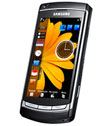The Samsung Omnia HD, also known in some countries as the i8910, engenders awe as the first impression. The huge screen dominates most of the front, allowing only small concessions to utility with the buttons along the bottom edge.
The phone is obviously packed with a number of features, and Samsung has managed that while keeping the design good too.
Look, Design, Feel (/10)

It is hard to argue with the classics; black and glossy, the panels on the Samsung Omnia look simple and very effective. The sides are sparsely populated with jacks and slots for miscellaneous connectors like expansion cards, headphones, chargers, computer cords, etc. There are two speakers, one at either end of the phone, rendering all audio output stereophonic.
All in all, there is no clutter around the edges. The design is kept simple and to the point.
Features (/10)

There isn't much that hasn't been incorporated into the Samsung Omnia HD. Barring a hardware keypad, which isn't entirely necessary itself, the others are negligible. However, the features which it does have are far from that.
First off, the touchscreen is a respectable 3.7 inches. The technology that has been used is capacitative, so the handling of the phone is intuitive and smooth. There are three hard buttons along the bottom edge of the front, and there is a user-facing camera and a proximity sensor on the top. The screen is widescreen, of crystal clarity and supports 16 million colours, making video playback a positive treat from almost any angle.
The camera is phenomenal, with 8 megapixels and an LED flash. Of course, there is the standard autofocus and the not-so-standard face and smile detection engine. There is also blink photo detection, added in for good measure. The camera allows video recording at 24 fps, thereby earning the Omnia its HD tag.
Audio playback is of sterling quality thanks to the DNSe (Digital Natural Sound engine) and Dolby, notwithstanding the stereo speakers on the outside.
There are three customizable home screens, accessible by pulling the one visible out of the way. Widgets are organized in a toolbar running alongside the left edge of the phone. They can be dragged into the greater part of the screen for a closer view.
The menu is classic Symbian, with a choice between list of grid views. The icons can be reorganized through drag-and-drop, while double-clicks open applications.
Interestingly, there are three ways of data entry: one is a onscreen QWERTY keyboard which is surprisingly easy to use; the second is an alphanumeric with T-9, reminiscent of the old school keypads, and the third is simply to inscribe letters onscreen with the tip of a finger.
Connectivity (/10)
Starting with quad-band GSM and HSDPA, the Samsung Omnia HD covers its 2G and 3G bases. Bluetooth is pretty much a given, although there is no infrared. Thankfully manufacturers seemed to have agreed that it is now redundant. There is Wi-Fi support too.
There is GPS and an advanced version called GPS+. These are available for an extra rental and are dependent on the carrier in question. However, their inclusion in the specifications means that the user can easily geo-tag their content for direct upload into services like Google Maps.
Performance (/10)
With a 256 MB RAM and a strong processor, the Samsung Omnia HD does not drag its feet. It has the Symbian mobile operating system incorporated into it, so it directly benefits from its multi-threading abilities. The Omnia has easily manage multiple applications running simultaneously in the background without turning catatonic.
Value for Money (/10)
A little on the expensive side, the Samsung Omnia does however justify the extra expense. The phone is packed with features, and has a great design in addition. It is not a phone to be taken lightly though, and it is a definite investment that requires careful consideration first.
Pros
+ Large touchscreen, with widescreen and capacitive technology
+ 8 megapixel camera
+ HD video recording and playback
+ Excellent audio components like Dolby, DNSe and stereo speakers
+ Smooth transitional effects and intuitive touchscreen technology
Cons
- No hardware QWERTY keyboard
- Screen is practically useless in strong sunlight
- Sports Symbian's classic GUI, therefore the design is dated
